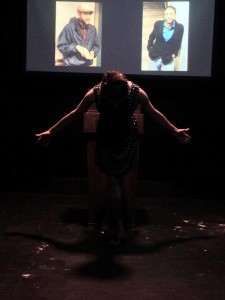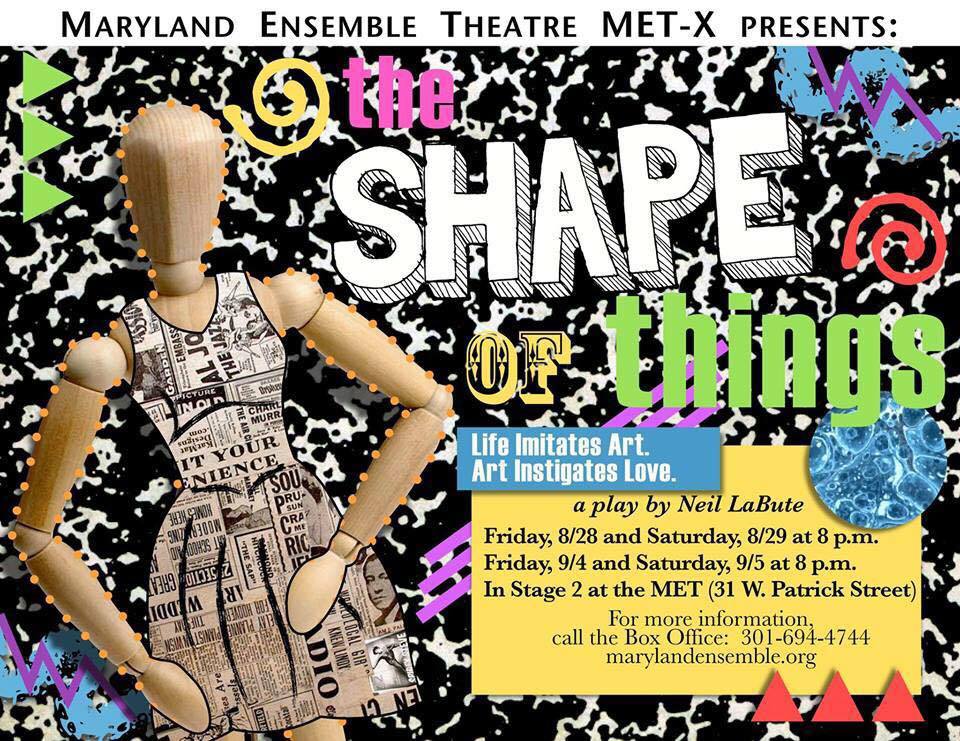Anyone can be provocative. But there is a line drawn between saying something artistic and just saying something for attention. At least there should be. Shouldn’t there? Are love and cruelty human heartfelt emotions or merely subjective terms thrown about loosely in the art scene for the sake of creating truth in art? In a twisted and evocative emotional drama, the Maryland Ensemble Theatre, through their MET-X Production Squad, discovers the honesty in art and poses the question ‘what makes art?’ and ‘when has art gone too far?’ in a compelling and versatile performance of The Shape of Things, written by Neil LaBute. Directed by Steve Custer, this production blurs the lines of art and all its inherent meanings using the most pliable but dangerous base materials known to man— the human flesh and the human soul.
In an invigorating and bold approach to blend the mediums of live stage art and videography, Director Steve Custer brings an intriguing approach of streamlining video recordings into the performance. Working with Videographer Jen Tonon to create hyper-realistic moments of character interaction, Custer fuses these video segments into the work of the play showing the audience glimpses of the emotional aftermath that the characters experience. The placement of these video clips occurs between scenes and serves an impressive two-fold purpose. Not only do the videos cover the scene changes that may otherwise be awkward in the intimate black box space, but they allow more ‘real-time’ action to occur in the timeframe of the show without having to make additions to the script or lengthen the overall run-time of the show.
Composer Matthew Ancarrow works closely with Custer and Tonon to augment the natural emotions of both the live acting and the videographic moments of the production. Creating original musical snippets to underscore certain moments, Ancarrow adds a level of polished completion to the show with these choices. There are moments, however, where the overlay of this music, while pleasing to the aural palette feels slightly contrived; the perfect tinkling of soft and sweet piano music underscoring a moment that is about to become sentimental reads as a guiding force to the audience, which at times is difficult to digest given the emotional turmoil of the show’s overall existence. Ancarrow does compose fantastically cheesy late 80’s/early 90’s synthesizer music that fits the opening video credits to perfection, and become the epitome of a bad sitcom-romdrom television special with the purposefully grainy video work of Tonon in the opening moments of the show.
Producing a show that focuses on art rarely gives the production team a chance to focus on local artists, but Director Steve Custer has taken this opportunity to feature the work of local artists Renee Gerrard in the performance. Using her subdued and simplistic yet inherently beautiful pieces to provide context for the backdrop throughout the show is both informative for audience purposes as we shift from location to location and a display of Gerrard’s talent. The pieces used in the projections, which serve to denote locations such as inside the doctor’s office and various apartments, are on display at the MET during the run of the show as well.
Custer’s direction moves the piece along at a gallop without compromising the informative nature and emotional onslaught of the plot. His casting choices and attention to character nuance help to fabricate a cohesive theatrical experience that reads as both a gut-check and a brain shocker. Treating the show in earnest as a simple drama, Custer allows the deeper layers of emotional and psychological to infuse the character’s dialogue and physical interactions without seeming forced into place. This naturalistic approach to the show makes its shocking conclusion and overall twisted plot unfold in a wicked and enjoyable, albeit ethically dubious, manner.
Despite the occasional vocal trail-off from the performers— which in the intimate Stage2 space of the MET makes the tail ends of lines difficult to grasp— the acting that is displayed within the show’s brief stage time is stellar, sharply honed, and tightly focused. The emotionally charged altercations and interactions not only feel solidly grounded in the character reality that has been crafted throughout the performance but they feel inherently earnest. Working exceptionally well together as a whole unit, these four performers make the 100-minute drama worth its time investment while simultaneously broadening the intellectual curiosities that arise from experiencing such a show.
Playing the simpering Jenny, MET company member Emily Raines unearths a rich inner life in the potentially static character. At first Raines delivers a vapid and seemingly unintelligent college girl who is complacent, albeit foolishly so, in her domestically progressive higher educated life. The emotional depth of her character’s situation is explored as the play ventures down the proverbial rabbit hole of uncharted territory and Raines’ performance broadens to display these discoveries. Revealing a tragic but honest internal monologue of Jenny’s emotional distresses later in the play showcases Raines’ ability to develop dimensions for an otherwise obtuse character.
Ian Hoch delivers an edgy and visceral rendition of the stereotypical jerk on campus. Hoch navigates the nuances of Adam’s dousche-like qualities so that they feel realistic and not like a polished caricature. His most intense and impressive scenes are not his scenes spent engaging in hot-headed behavior, but rather the ferocious tension that builds and burbles between he and Adam (Giovanni Kavota) over their disseminating friendship. In a scene close to the show’s end there is a furious vocal exchange that pinpoints the angst inside of Hoch’s character with a microscopic laser. His portrayal on the whole is engaging and crowned by that moment.
Kavota, who is also an MET company member, delivers a shocking series of transformations throughout the performance as he works the character to its full potential. For fear of plot spoilers, it can only be said that the emotional weight of his character shifts perpetually with fascinating ease. His overall ability to command attention with his presence, despite the character’s initial awkwardness is commendable. Delivering a stunning series of scenes that run the gamut of emotional details, Kavota is an impressive character force held against company member Devin Gaither, who plays Evelyn.
Gaither and Kavota execute perfectly crafted moments of awkwardness in their initial meeting and the chemistry between them is the stuff of romantic stories. This occurs in a fashion most natural, which is both endearing and surprising as this sort of chemistry often feels contrived. Their interactions, particularly the perfectly crafted pregnant pauses in their opening scene, resonate with a resounding truthfulness, which in itself is an irony given that the quest for truth in art is the central conceit of the show.

As the show’s leading lady, Gaither drops a performance bomb the effects of which are still being felt long after the show has concluded. Visceral and ruthless, the edgy verve with which she attacks the character of Evelyn is astounding. Delving so much deeper than the malleable surface of her character’s biting artistic exterior, Gaither unveils layer after layer of Evelyn in a fashion that builds a bond of trust with not only the characters on stage but those in the audience. When her shocking final scene is revealed, the harrowing kick to the gut is felt and heard across the space. Gaither’s performance is fierce, a harrowing mark of living art that zings the message of the show home with a fiery, albeit underhanded, punch of panache.
An exceptional exploratory performance with great performances and the chance to experience a rarely performed Neil LaBute work, The Shape of Things will work your mind into another shape entirely at the Maryland Ensemble Theatre this summer.
Running Time: Approximately 100 minutes with no intermission
The Shape of Things plays through September 5, 2015 as a part of MET-X at the Maryland Ensemble Theatre in their Stage2 Performance Space— 31 West Patrick Street in historic Frederick, MD. For tickets please call the box office at (301) 694-4744 or purchase them online.


